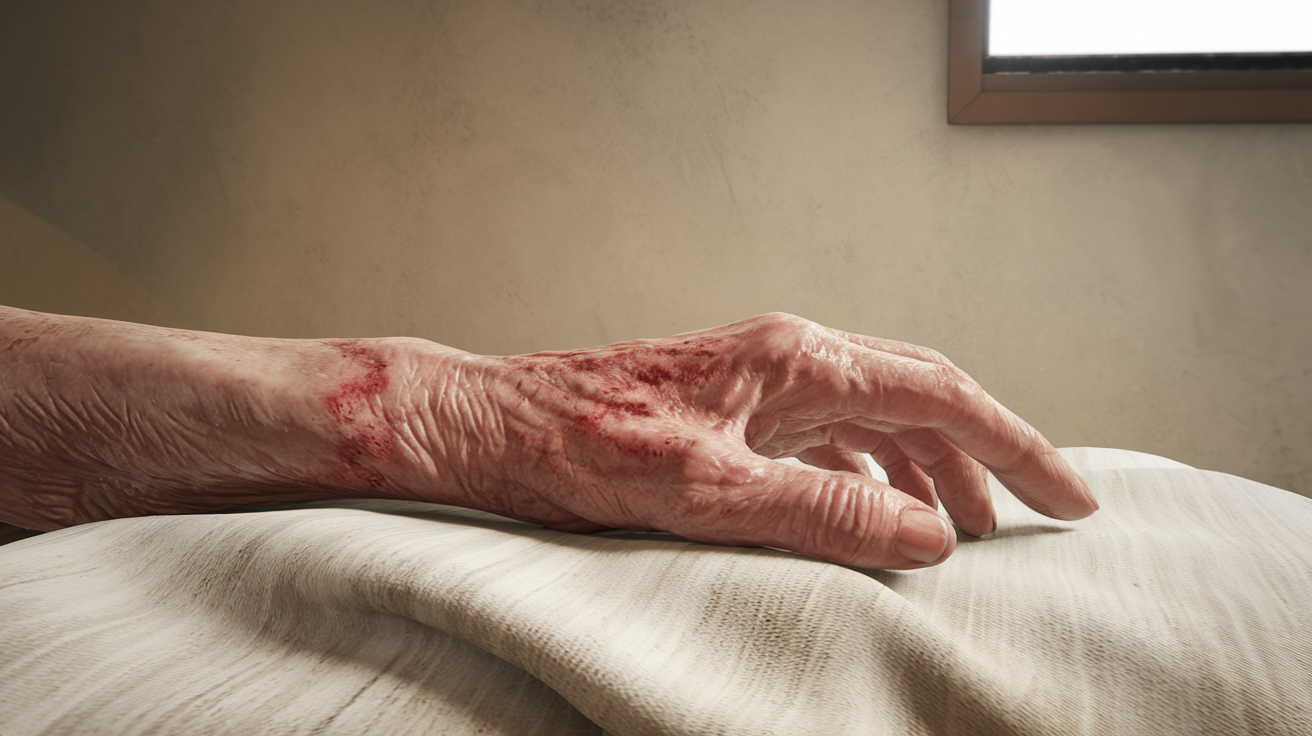Recognizing and Reporting Signs of Nursing Home Abuse
Recent studies indicate that more than one-in-ten older adults in New York State will be victims of abuse over a ten-year period.[1] Recent studies on the abuse of the elderly in institutional settings such as nursing homes—indicate that over sixty-four percent (64%) of staff in these facilities reported perpetrating an act of elder abuse in the last year.[2]
Horrific on their own, these statistics likely fail to capture the full picture. Another recent study estimates that just one in 24 cases of abuse are reported to the authorities.[3] The trend of underreporting likely accords in New York State as well.
In a new report, the Long-Term Care Community Coalition (the “LTCCC”) finds that New York State consistently ranks at or near the bottom in terms of enforcing nursing home oversight laws through citations.[4] The lack of citations in New York matters because a state’s efficacy in overseeing nursing home care boils down to (1) the state’s ability to identify and cite facilities when they fail to meet existing standards and (2) the state’s ability to rate the severity of the deficiencies.[5] In its proper context, this report suggests New York is consistently failing to monitor and enforce the law in with respect to the control of infectious diseases, staffing and funding requirements, legal requirements pertaining to residents’ quality of life, and the enforcement of residents’ rights.
In light of these reports, it is even more important to be vigilant when an older person you know is living in a nursing home or other long-term care facility. This article defines the different types of nursing home abuse, how to recognize the signs of these abuses, and how protect our loved ones by documenting abuse and properly reporting it.
If these measures are insufficient then it is important to promptly contact an attorney to protect the nursing home resident. Reach out to schedule your free consultation with the nursing home abuse attorneys at Dansker & Aspromonte by calling us at (516) 774-3988 or by contacting us through our online portal, which is linked here.
Who is at Risk of Nursing Home Abuse?
Abuse happens in every nursing home community. However, certain populations with specific risk factors face greater risks of being victimized in nursing homes and other long-term care facilities. Those with greater risk of being abused in a nursing home are typically those older people who:
- are experiencing social isolation or otherwise have limited social support;
- dealing with dementia or mental health issues;
- have a physical disability or other issues with their physical health;
- have lower socioeconomic status;
- have high levels of stress and poor coping mechanisms;
- have previously been exposed to trauma;
- have low income or less financial independence; and
- have a history of substance abuse or addiction.[6]
Further, both race and gender factor into the likelihood that a person will be the victim of nursing home abuse.[7] Men and women from different cultures are more and less likely to face specific types of abuse in the context of a nursing home.[8] For example, older Hispanic adults are more likely to face abuse if they have a history of abuse, but prior abuse is a protective factor against nursing home abuse where older African American women are concerned.[9] That people from different racial and gender backgrounds face different risks of nursing home abuse based on their background means that interventions into nursing home abuse cases should recognize and respect the cultural differences of each victim.
What Constitutes Nursing Home Abuse?
Generally speaking, nursing home abuse is an action or lack of appropriate actions that cause harm, risk of harm, or distress to a person who is sixty years or older.[10] This abuse must occurs in either a relationship in which there is an expectation of trust or when the action (or lack thereof) is directed towards an older person specifically because of their age or disability.[11] Speaking generally, there are five types of nursing home abuse. Each will be discussed briefly below.
Physical Abuse
The term physical abuse means intentionally applying physical force to an elderly person’s body that results in bodily injury, pain, or any other type of impairment to an elderly person’s body in the context of nursing home abuse.[12] Physical abuse accounts for approximately 9.3% of all nursing home abuse incidents.[13]
Neglect: Willful & Passive
Neglect is a form of nursing home abuse that comes in two forms: intentional and unintentional. Willful (or intentional) neglect occurs when a nursing home resident’s caregiver purposefully denies them access to medication, medical care, shelter, food, a therapeutic device, or other types of necessary physical assistance.[14] However, this type of abuse is also perpetrated when someone exposes a nursing home resident to the risk of physical, mental, or emotional harm without their express desire to face those risks.[15]
Passive (or unintentional) neglect occurs when a caregiver owes a duty to the nursing home resident to perform some service for that resident, fails to perform that service, and as a result, the resident goes without food, clothing, shelter, or medical care.[16] Together, willful and passive neglect together account for approximately 14.1% of all nursing home abuse cases.[17]
Financial Abuse or Exploitation
Financial abuse occurs when someone misuses or steals the financial resources or property from a nursing home resident. Financial abuse of the elderly is thought to cause $28.3 billion in losses on an annual basis.[18] That makes sense when one considers how common financial abuse of the elderly is: 13.8% of all elder abuse cases are financial abuse.[19]
Emotional or Psychological Abuse
A perpetrator commits an act of emotional (also known as psychological) abuse when he or she verbally assaults, threatens to abuse, intimidates, or otherwise harasses a nursing home resident.[20] Emotional abuses commonly do so by isolating the older person from their families and treating them like children.[21] This type of abuse is shockingly common: about 64.2% of all nursing home abuse cases involve emotional or psychological abuse.[22]
Identifying Nursing Home Abuse
Why is Nursing Home Abuse Difficult to Identify?
Nursing home abuse is often very difficult to identify because it occurs in a pattern that includes both the physical and social isolation of the victim—meaning there are usually no witnesses and often no one who would notice.[23] Further, many elderly victims are unable to speak due to onsetting dementia or other impairments, and, to make matters worse, many older people are simply not believed when they do speak out.[24]
Nursing home residents reported a reluctance to report abuse, citing the following reasons:
- shame and embarrassment;
- fear that their abuser will get in trouble;
- worry that they will be forced to live in a different nursing home;
- guilt or beliefs that they are to blame;
- denial that the abuse is occurring or an unawareness that the events constitute abuse or neglect; and
- fear that the abuse will get worse if they report it.[25]
Recognizing Physical Signs
Nursing home abuse often leave observable physical signs, including:
- unexplained bruises, cuts, burns, or scars;
- in severe cases of physical abuse, one may find lacerations, rope marks, fracture or broken bones, or other signs of being restrained;
- a dismissive attitude toward or dismissive statements about injuries;
- a lack of basic hygiene;
- unexplained weight loss in the older person due to inadequate food or water;
- unsanitary living conditions;
- dirty or inappropriate clothing for the weather or conditions; and
- untreated bedsores.[26]
Behavioral and Emotional Indicators
Nursing home abuse of all kinds may also be reflected in changes to the older person’s behavior or emotional state. These types of indicators include:
- increased rates of depression or anxiety in the nursing home resident;
- unreasonable fears or suspicions regarding seems that otherwise seem innocuous; and
- sudden, inexplicable changes in behavior;
- agitation, trembling, confusion, or a general disorientation;
- emotional distress such as crying; or
- withdrawal or flat/unemotional affect.[27]
Isolation should raise an alarm in this context. It is cause for concern if someone at the nursing home facility is restricting the older person’s contact with you or any other person.[28] An older person who is being deprived of the opportunity to speak with others with without the presence of a particular person is being isolated from others.[29]
Signs of Financial Exploitation
Financial abuse can be difficult to detect, but there is likely to be signs or other documentary evidence indicating that abuse.[30] The ten signs of financial exploitation look like:
- financial activities (such as purchases or bank withdrawals) that substantially deviate from the older person’s typical financial habits;
- requests for additional ATM cards or the use of an ATM card for the first time or in an unusual way;
- actions that transfer power over the nursing home resident’s finances to another such as opening a joint bank account, changing power of attorney, changing the account’s beneficiary, or opening inappropriate investments;
- sudden transfers of property or changes to the will or other estate planning documents;
- new authorized users of debit or credit cards;
- redirecting the older person’s mail to a different address;
- checks written out of numerical order;
- a flurry of bounced checks, overdraft fees, or low balances in bank accounts;
- large withdrawals from inactive accounts; and
- a frivolous or baseless petition for guardianship over the older person.[31]
Indicators of Neglect
Remember: nursing home neglect is nursing home abuse. It is the nursing home’s responsibility to care for the older person, and their failure to do so constitutes neglect. Neglect can go unnoticed for a long time, but it will typically have signs such as:
- dehydration or malnutrition on the older person’s part;
- untreated bedsores;
- poor personal hygiene on the part of the older person;
- soiled or otherwise unclean clothing;
- wearing clothing that is inappropriate for the occasion or weather;
- unreceived medications; and
- untreated health problems.[32]
Documenting Suspected Abuse
If you suspect that an elderly person you care about is being abused in a nursing home then it is critical that you document the bases for your suspicion. As noted earlier, nursing home abuse is difficult to report and prove because it often involves an isolated victim with the nursing home caregiver controlling most of the evidence. Here are some best practices for documenting suspected abuse.
Take Detailed Notes
If you see something that concerns you then write it down. Make sure to write down:
- the date, time, and location that you saw it;
- a description of what happened in close detail, including everything you saw and heard;
- the names of all of the staff members, residents, visitors and any person who witnessed it or who you think might know something about the incident; and
- any changes in the victim’s behavior that you have observed since the incident of abuse.
Take Photos & Videos
A picture says a thousand words; a video says more. Try to get a photo or a video of any bruises, cuts, burns, bedsores, or other visible injury you encounter. Make sure to photograph the unsanitary conditions that evidence neglect. Capture images of the signs of malnutrition such as weight loss, cracked lips, or dry skin.
Preserve Your Records
To best report this, keep track of all of the relevant records, including:
- copies of medical records or reports;
- written correspondence between yourself and people from the facility; and
- documentation of any financial transactions such as bills, missing checks, and bank statements.
Store Your Evidence in a Safe Place
Make sure to store all of the evidence you collect in a safe place, keeping it as orderly as you possibly can.
Reporting the Abuse
There are numerous avenues through which you can report the abuse under New York or federal law. These include:
- New York State Adult Protective Services (“APS”): APS intakes, investigates, and assesses referrals of abuse, neglect, and financial exploitation of adults who cannot protect themselves. APS is for cases in which the older person does not have someone who is willing and able to assist responsibly.
- New York State Department of Health (“DOH”): DOH specifically addresses complaints about nursing homes, assisted living facilities, and adult care facilities licensed by the state. A complaint against a nursing home can be filed by calling their hotline: 1-888-201-4563. Alternatively, a complaint can be filed on DOH’s website, which you will find linked here.
- New York State Department of Financial Services (“DFS”): Complaints of exploitation, fraud, scams, or other unauthorized transactions can be reported to the New York Department of Financial Services at this link.
- New York State Office of the Long-Term Care Ombudsman Program (“LTCOP”): LTCOP handles complaints about nursing homes and issues concerning the rights of people who live in assisted living facilities. An “ombudsman” is a person who advocates for nursing home residents and mediates their situations to help achieve a mutually beneficial resolution of their situation. Claudette Royal is the New York State Ombudsman and can be contacted at this email address: ombudsman@aging.ny.gov.
Talk to Your Loved One
If you suspect that your loved one is being abused then the first thing you should do is speak with the one-on-one in a comfortable situation. By speaking with them alone, you can encourage honesty. Make sure they are fully prepared to participate in the conversation by ensuring they have any sensory aids they need. This conversation will be most productive if they feel respected, heard, and empowered to address the abuse at issue.
Conclusion & FAQ
As demonstrated above, nursing home abuse is a complex problem that comes in many forms, but there are steps you can take to prevent and stop it. Remain vigilant for the signs of abuse, and document everything once you begin to suspect that there is ongoing abuse. File a report with the appropriate agency. Try to have a conversation with your loved one to see what you can do to help them.
If all else fails, you or your loved one may need experienced attorneys who understand nursing home abuse cases. If that is where you find yourself then call the nursing home abuse attorneys at Dansker & Aspromonte today to schedule your free consultation. Schedule your free consultation with our attorneys by calling us at (516) 774-3988 or by reaching out to us through our online portal, which is linked here.
[1] Burnes, D., Lichtenthal, P. R. L., Lachs, M. S., & Pillemer, K. A. (2022, April 18).
Estimated Incidence and Factors Associated With Risk of Elder Mistreatment in New York State.
Retrieved from
https://pmc.ncbi.nlm.nih.gov/articles/PMC9014652/
[2] World Health Organization. (2024, June 15).
Abuse of older people.
Retrieved from
https://www.who.int/news-room/fact-sheets/detail/abuse-of-older-people
[3] National Center on Elder Abuse. (2024, July 8).
Prevalence of Elder Mistreatment. National Council on Aging.
Retrieved from
https://www.ncoa.org/article/get-the-facts-on-elder-abuse/
[4] Long Term Care Community Coalition. (2025, February 10).
LTCCC Alert: Oversight Overlooked in New York Nursing Homes.
Retrieved from
https://nursinghome411.org/alert-ny-oversight-overlooked/
[5] Long Term Care Community Coalition. (2025, February 12).
Broken Promises: An Assessment of Nursing Home Oversight.
Retrieved from
https://nursinghome411.org/reports-old/survey-enforcement/survey-data-report/
[6] National Center on Elder Abuse. (2025, February 12).
Risk Factors & Protective Factors.
Retrieved from
https://ncea.acl.gov/riskfactorsandprotectivefactors#gsc.tab=0
[7] National Center on Elder Abuse. (2023, April).
Risk and Protective Factors of Elder Abuse for Community-Dwelling Racial Minorities.
Retrieved from
https://pfs2.acl.gov/strapib/assets/NCEA_RT_Riskand_Protective_Factors_EA_Community_Dwelling_Racial_Minorities_2023_4fdf92c648.pdf
[8] National Center on Elder Abuse. (2023, April).
Risk and Protective Factors of Elder Abuse for Community-Dwelling Racial Minorities.
Retrieved from
https://pfs2.acl.gov/strapib/assets/NCEA_RT_Riskand_Protective_Factors_EA_Community_Dwelling_Racial_Minorities_2023_4fdf92c648.pdf
[9] National Center on Elder Abuse. (2023, April).
Risk and Protective Factors of Elder Abuse for Community-Dwelling Racial Minorities.
Retrieved from
https://pfs2.acl.gov/strapib/assets/NCEA_RT_Riskand_Protective_Factors_EA_Community_Dwelling_Racial_Minorities_2023_4fdf92c648.pdf
[10] New York State Bar Association. (2025, February 12).
Elder Abuse: An FAQ for Attorneys.
Retrieved from
https://nysba.org/app/uploads/2020/02/elderabuseFAQ-2.pdf
[11] New York State Bar Association. (2025, February 12).
Elder Abuse: An FAQ for Attorneys.
Retrieved from
https://nysba.org/app/uploads/2020/02/elderabuseFAQ-2.pdf
[12] National Center on Elder Abuse. (2024, July 8).
Prevalence of Elder Mistreatment. National Council on Aging.
Retrieved from
https://www.ncoa.org/article/get-the-facts-on-elder-abuse/
[13] Yon, Y., Mikton, C., Gassoumis, Z., & Wilber, K. (2019).
The prevalence of elder abuse in institutional settings: A systematic review and meta-analysis.
European Journal of Public Health, 29(1), 58–67.
Retrieved from
https://pubmed.ncbi.nlm.nih.gov/29878101/
[14] National Center on Elder Abuse. (2024, July 8).
Prevalence of Elder Mistreatment. National Council on Aging.
Retrieved from
https://www.ncoa.org/article/get-the-facts-on-elder-abuse/
[15] National Center on Elder Abuse. (2024, July 8).
Prevalence of Elder Mistreatment. National Council on Aging.
Retrieved from
https://www.ncoa.org/article/get-the-facts-on-elder-abuse/
[16] National Center on Elder Abuse. (2024, July 8).
Prevalence of Elder Mistreatment. National Council on Aging.
Retrieved from
https://www.ncoa.org/article/get-the-facts-on-elder-abuse/
[17] Yon, Y., Mikton, C., Gassoumis, Z., & Wilber, K. (2019).
The prevalence of elder abuse in institutional settings: A systematic review and meta-analysis.
European Journal of Public Health, 29(1), 58–67.
Retrieved from
https://pubmed.ncbi.nlm.nih.gov/29878101/
[18] National Center on Elder Abuse. (2024, July 8).
Prevalence of Elder Mistreatment. National Council on Aging.
Retrieved from
https://www.ncoa.org/article/get-the-facts-on-elder-abuse/
[19] Yon, Y., Mikton, C., Gassoumis, Z., & Wilber, K. (2019).
The prevalence of elder abuse in institutional settings: A systematic review and meta-analysis.
European Journal of Public Health, 29(1), 58–67.
Retrieved from
https://pubmed.ncbi.nlm.nih.gov/29878101/
[20] National Center on Elder Abuse. (2024, July 8).
Prevalence of Elder Mistreatment. National Council on Aging.
Retrieved from
https://www.ncoa.org/article/get-the-facts-on-elder-abuse/
[21] N.Y. Elder Law Practice § 1:6 (2024 ed.).
[22] Yon, Y., Mikton, C., Gassoumis, Z., & Wilber, K. (2019).
The prevalence of elder abuse in institutional settings: A systematic review and meta-analysis.
European Journal of Public Health, 29(1), 58–67.
Retrieved from
https://pubmed.ncbi.nlm.nih.gov/29878101/
[23] New York State Bar Association. (2025, February 12).
Elder Abuse: An FAQ for Attorneys.
Retrieved from
https://nysba.org/app/uploads/2020/02/elderabuseFAQ-2.pdf
[24] New York State Bar Association. (2025, February 12).
Elder Abuse: An FAQ for Attorneys.
Retrieved from
https://nysba.org/app/uploads/2020/02/elderabuseFAQ-2.pdf
[25] New York State Bar Association. (2025, February 12).
Elder Abuse: An FAQ for Attorneys.
Retrieved from
https://nysba.org/app/uploads/2020/02/elderabuseFAQ-2.pdf
[26] American Psychological Association. (2024, July 8).
Elder Abuse: How to spot warning signs, get help, and report mistreatment.
Retrieved from
https://www.apa.org/topics/aging-older-adults/elder-abuse
[27] American Psychological Association. (2024, July 8).
Elder Abuse: How to spot warning signs, get help, and report mistreatment.
Retrieved from
https://www.apa.org/topics/aging-older-adults/elder-abuse.
New York State Bar Association. (2025, February 12).
Elder Abuse: An FAQ for Attorneys.
Retrieved from
https://nysba.org/app/uploads/2020/02/elderabuseFAQ-2.pdf
[28] New York State Bar Association. (2025, February 12).
Elder Abuse: An FAQ for Attorneys.
Retrieved from
https://nysba.org/app/uploads/2020/02/elderabuseFAQ-2.pdf
[29] New York State Bar Association. (2025, February 12).
Elder Abuse: An FAQ for Attorneys.
Retrieved from
https://nysba.org/app/uploads/2020/02/elderabuseFAQ-2.pdf
[30] New York State Bar Association. (2025, February 12).
Elder Abuse: An FAQ for Attorneys.
Retrieved from
https://nysba.org/app/uploads/2020/02/elderabuseFAQ-2.pdf
[31] New York State Bar Association. (2025, February 12).
Elder Abuse: An FAQ for Attorneys.
Retrieved from
https://nysba.org/app/uploads/2020/02/elderabuseFAQ-2.pdf
[32] American Psychological Association. (2024, July 8).
Elder Abuse: How to spot warning signs, get help, and report mistreatment.
Retrieved from
https://www.apa.org/topics/aging-older-adults/elder-abuse






